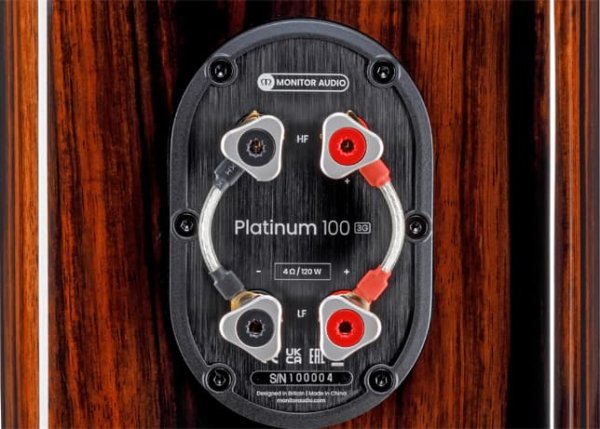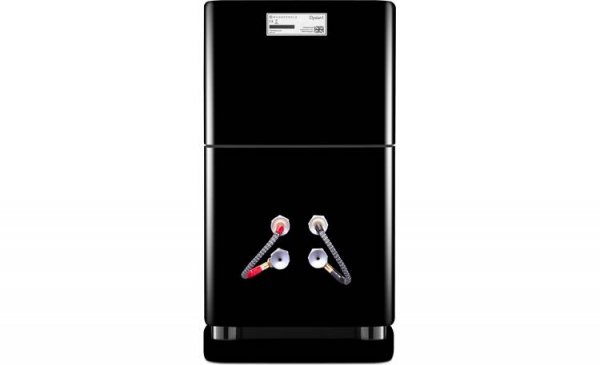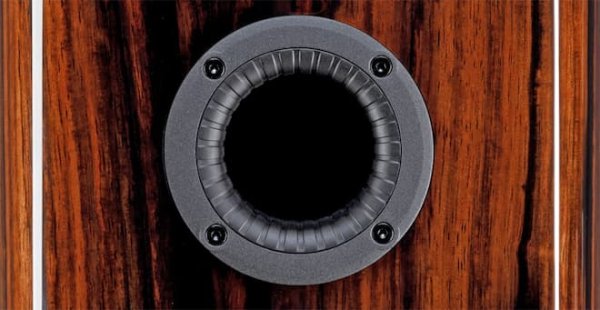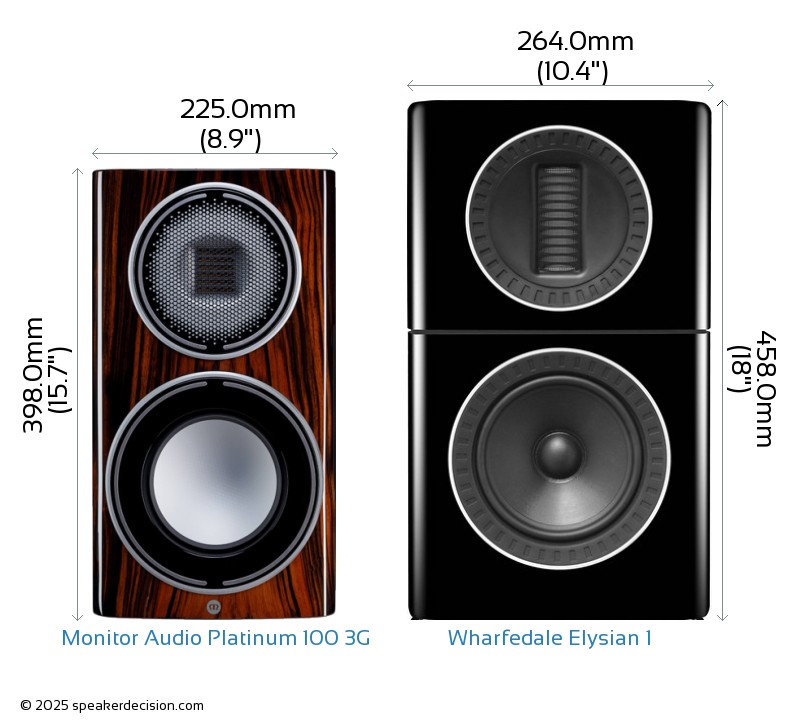In this review, we will be comparing Platinum 100 3G and Elysian 1, two Passive Bookshelf speakers from Monitor Audio and Wharfedale.
Let's have a brief look at the main features
of Monitor Audio Platinum 100 3G and Wharfedale Elysian 1 first before getting into our more
detailed comparison.
Monitor Audio Platinum 100 3G Key Specs
- 2-way Design
- 1" Tweeter
- 6" RDT III Woofer
- 28-60k Hz Frequency Response
- 85dB Sensitivity
- Impedance: 4ohms
- Power Range:up to 150watts
- Weight:15.20kg
- Dimensions (H x W x D): 398.0" x 8.8" x 12.8"( 398 x 225 x 325.6 mm )
Wharfedale Elysian 1 Key Specs
- 2-way Design
- 27x90mm" AMT (Ribbon) Tweeter
- 7" Coated Fiberglass Woofer
- 49-22k Hz Frequency Response
- 89 dB Sensitivity
- Impedance: 4ohms
- Power Range:25-175watts
- Weight:15.03kg
- Dimensions (H x W x D): 458.0" x 10-3/8" x 12-7/16"( 458.0 x 264.0 x 316.0mm )
What size room are the Monitor Audio Platinum 100 3G and Wharfedale Elysian 1 speakers good for?
The size of the room in which you are planning to use these loudspeakers is an important decision
factor. Here we have compared their suitability to various sizes of environments considering their size
and max power parameters:
| Listening Environment* |
Monitor Audio Platinum 100 3G |
Wharfedale Elysian 1 |
| Near-field |
Poor |
Poor |
| Small Room |
Average |
Average |
| Mid-size Room |
Good |
Good |
| Large Room |
Average |
Average |
| Very Large Room |
Poor |
Poor |
(* Approximate Room sizes: Small < 100sq. ft / 9 m2,
Mid-size: 100-220 sq. ft / 9-20 m2, Large 220-400 sq. ft / 20-36 m2, Very Large: >
400 sq. ft / 36 m2.
Average Floor Height: 9" / 2.7m. Typical room sizes differ from country to country, and the actual
listening experience changes depending on floor height, room shape, surface materials, listening
position, speaker locations, etc.)
In the following sections, we will get into more detail in order to better understand how the Monitor Audio Platinum 100 3G and Wharfedale Elysian 1 compare and hopefully end up with enough arguments to decide which one of these loudspeakers is the better choice for you.
**This post contains affiliate links, and I will be compensated if you make a purchase after clicking
through my links. As an Amazon Associate I earn from qualifying purchases.
Drivers
Both Platinum 100 3G and Elysian 1 are 2-way speakers.
| Driver |
Monitor Audio Platinum 100 3G |
Wharfedale Elysian 1 |
|
Driver Setup
|
2-way
|
2-way
|
|
Tweeter
|
1-inch
|
27x90mm-inch
|
|
Midrange
|
- |
- |
|
Woofer
|
1 x 6-inch
|
1 x 7-inch
|
Platinum 100 3G features a 1" MPD III Tweeter and 1 x 6" RDT III Woofer with a Crossover frequency at 2850 Hz. On the other hand, the Elysian 1 features a 27x90mm" AMT (Ribbon) Tweeter and 1 x 7" Coated Fiberglass Woofer with a Crossover frequency at 2500Hz.
Frequency Response
Platinum 100 3G has a frequency range of 28-60k Hz whereas Elysian 1 has a frequency range of 49-22k Hz. With a minimum frequency of 28Hz, the Platinum 100 3G can go significantly deeper on the low side and provide stronger bass compared to the Elysian 1's min frequency of 49Hz.
Below graphs depict how these two speakers compare with the max, min and average values of the Min and Max Frequencies of other speakers in the Bookshelf class in our database.
Low Frequency
Bookshelf Speakers
High Frequency
Bookshelf Speakers
Monitor Audio Platinum 100 3G
None of these speakers achieves full range experience which is commonly agreed as 20Hz-20kHz. In order to achieve lower lows / deeper bass, we recommend you pair these with a subwoofer. Visit our Powered Subwoofers section to find out more about the available options.
Impedance and Sensitivity
Platinum 100 3G and Elysian 1 have the same Impedance of 4 ohms but where they differ is the sensitivity levels. Platinum 100 3G sensitivity is rated at 85dB and the Elysian 1's is at 89 dB. This 4 dB difference makes the Wharfedale Elysian 1 a more sensitive speaker compared to Monitor Audio Platinum 100 3G, hence will play louder with the same amount of watts.
One thing to keep in mind that the lower impedance speakers, especially the ones that are rated at 4 ohms may put more pressure on the amplifier unit comared to higher impedance speakers especially at high volume levels, so make sure the amp you pair with the Platinum 100 3G and the Platinum 100 3G can provide this impedance level.
Sensitivity
Bookshelf Speakers
Power Range
Power
range is the range of input power in watts RMS that a loudspeaker is designed to handle. While using
an amplifier within this range ensures the nominal performance , inputting a power that is higher than the
max wattage can result in a damaged speaker.
Platinum 100 3G can handle a max power of 175 watts RMS from the amp the whereas Platinum 100 3G has a max power handling value of 150 watts RMS , 25 watts less than the Elysian 1.
Keep in mind that a higher max power handling value doesn't necessarily make that a louder speaker
compared to a lower max handling speaker. Loudness or the sound level is also impacted by parameters
such as Impedance, sensitivity and system efficiencies.
Input Type and Bi-Amping / Bi-Wiring
Both Platinum 100 3G and Elysian 1 features dual binding post speaker terminals for bi-amping or bi-wiring.
 Monitor Audio Platinum 100 3G's Binding post terminals allows Bi-amping or bi-wiring
Monitor Audio Platinum 100 3G's Binding post terminals allows Bi-amping or bi-wiring
 Wharfedale Elysian 1's Binding post terminals allows Bi-amping or bi-wiring
Wharfedale Elysian 1's Binding post terminals allows Bi-amping or bi-wiring
Cabinet Type and Port Position
Platinum 100 3G has a rear firing port whereas Elysian 1 has a bottom firing ports. Wharfedale Elysian 1's bottom-firing port gives more flexibility in placement in regards to proximity to walls compared to Monitor Audio Platinum 100 3G with its rear-firing port.
 Monitor Audio Platinum 100 3G Port
Monitor Audio Platinum 100 3G Port
Physical Specs
Size of a speaker can sometimes become an important decision factor due to space constraints or in some cases purely for esthetic reasons. In this section, we are going to compare Monitor Audio Platinum 100 3G's and Wharfedale Elysian 1's external dimensions. Monitor Audio Platinum 100 3G has external dimensions of 398 x 225 x 325.6 mm ( 15.6 x 8.8 x 12.8-inch) whereas Wharfedale Elysian 1 has external dimensions of 458.0 x 264.0 x 316.0mm ( 18-24 x 10-3/8 x 12-7/16inch) .
Monitor Audio Platinum 100 3G is 39mm narrower and 60mm shorter than Wharfedale Elysian 1 but it is also 9mm deeper.
Below you can see the front view size comparison of Monitor Audio Platinum 100 3G and Wharfedale Elysian 1 in scale.
 Comparison image of Monitor Audio Platinum 100 3G and Wharfedale Elysian 1 Size and External Dimensions
Comparison image of Monitor Audio Platinum 100 3G and Wharfedale Elysian 1 Size and External Dimensions
Base Surface Area Comparison
Base surface area of a loudspeaker may become a determining factor when the space in your room or desk is limited.
The base surface area of the Monitor Audio Platinum 100 3G is approximately 731.3cm2 / 113.4inch2 and base area of the Wharfedale Elysian 1 is approximately 834.2cm2 / 129.3inch2. The Platinum 100 3G requires 12% less surface area than the Elysian 1 which gives it a small advantage on placement in tight spaces.